方案详情文
智能文字提取功能测试中
1605年,伽利略·伽利莱进行了第一次已知的摆动运动研究,并发现了摆动的周期保持不变。自那时以来,摆钟、弹道摆、地震仪、节拍器、黏度计和高层建筑的质量减震器等技术应用中都广泛使用了摆。此外,摆也是一种“教育经典”和研究振动运动概念的标准装置,从无阻尼情况和简谐运动开始(Mongelli和Battista 2020)。物理摆在流体流动和流体-结构相互作用研究中也有悠久的传统,包括增加质量和流体摩擦等概念。Williamson&Govardhan(1997)和Govardhan&Williamson(1997, 2005)通过测量均匀流中类似于摆的系球的运动,对理解涡诱导振动做出了重要贡献。他们发现三种不同的振幅和频率响应模式,导致升力和阻力力的显着波动。与静止球的阻力测量相比,球的振动几乎使阻力翻了一倍。此外,他们指出了理解尾迹和涡动力学对解释响应现象的重要性,并强调进行流体可视化对于解决这个问题的重要性(Williamson&Govardhan 1997)。近年来,流量测量技术的进展,特别是激光光学流量可视化,已经促使研究人员重新进行实验研究,以帮助更好地理解基本物理学。例如,van Hout,Krakovich&Gottlieb(2010),Eshbal,Krakovich&van Hout(2012)和Krakovich,Eshbal&van Hout(2013)使用粒子图像测速仪(PIV)密集地研究了均匀流中系球尾迹中的涡脱落。随着向三维(3-D)流场可视化的发展,van Hout等人(2018, 2022),Eshbal等人(2019a,b)和Kovalev,Eshbal&van Hout(2022)对系球在均匀流中的静止、运动自由的状态下进行了层析 PIV(tomo-PIV)测量。他们的发现扩展了我们对湍流边界层中流体结构相互作用和涡诱振相关的涡 shedding 行为的认识,并指出了三维流场测量的相关性。Crane 等人 (2022) 使用 tomo-PIV 方法研究了悬臂圆柱的涡 shedding 拓扑结构。然而,tomo-PIV 存在计算成本高和依赖于空间平均交叉相关的缺点,这会使速度梯度变得平滑 (Schanz, Gesemann & Schröder 2016)。因此,基于拉格朗日粒子追踪的方法,通常称为粒子跟踪测速技术 (PTV),变得更加流行 (Raffel 等人,2018)。如今,基于时间分辨率的三维粒子跟踪测速 (tr-3-D-PTV) 是三维流动测量中最先进的方法之一,并已证明其用于识别和可视化连续流结构和涡动力学的效用 (Schobesberger 等人,2022)。CrossMarkJ. Fluid Mech. (2023), vol. 960, A14, doi:10.1017/jfm.2023.170 T. Gold and others Lagrangian particle tracking velocimetry investigation of vortex shedding topology for oscillating heavy spherical pendulums u nderwater Thomas Gold l +t, Kevin Reiterer l , Dominik Worf l , Ali Khosronejad²,Helmut Habersack3 and Christine Sindelar 3 l Christian Doppler Laboratory for Sediment Research and Management, Institute of Hydraulic Engineering and River Research (IWA), Department of Water , Atmosphere and Environment (WAU),University of Natural Resources and Life Sciences, Am Brigittenauer Sporn 3, 1200 Vienna, Austria ?Department of Civi l Engineering, Stony Brook Universi t y, Stony Brook, New York 11794, USA 3Institute of Hydraulic Engineering and River Research (IWA), Department of Water, Atmosphere and Environment (WAU ), University of Natural Resources and Life Sciences, Am Brigit t enauer Sporn 3,1200 Vienna, Austria (Received 31 August 2022; revised 11 January 2023; accepted 22 February 2023) The vortex shedding topology of a heavy pendulum oscillating i n a dense f luid is S inves t igated using t i me-resolved three-dimensional particle t racking velocimetry (tr-3-D-PTV). A series of experiments with eight di f ferent solid to fluid mass ratios m* in the range [1.14,14.95] and corresponding Reynolds numbers of up to Re~0(104) was conducted. The period of oscillation depends heavily on m*. The relation between amplitude decay and osci l lation frequency is non-monotonic, having a damping optimum at m* ≈ 2.50. Moreover, a novel digital object t racking (DOT ) method using vorticity-magnitude iso-surfaces is i mplemented to analyse vortical structures. A similar vortex shedding topology is observed for various mass ratios m*. Our observat i ons show that first, a vortex ring in the pendulum’s wake is formed. Soon after, the i nit i al ring breaks down to two clearly distinguishable structures of simi l ar size. One of the two vortices remains on the circular path of the pendulum, while the other detaches, propagates downwards, and eventual l y dissipates. The t ime when the f irst vortex is shed, and its i ni t ial propagation velocity, depend on m* and the momentum imparted by the spherical bob.The findings further show good agreement between the experimentally determined vortex shedding frequency and the theoretical vortex shedding t ime scale based on the Strouhal number. Key words: vortex shedding, vortex dynamics, vortex interactions 1. Introduction The f irst known study of pendulum motion was carried out by Galileo Galilei i n 1605 as he discovered that the period of the swings remained constant. Since then, pendulums have been subject to much research and utilised i n many technical applications, such as, among others, the pendulum clock, bal l istic pendulums, seismometers, metronomes,viscosimeters and mass dampers in high-rise bui l dings (Mongelli & Batt i sta 2020; Worf et al. 2022). Also, the pendulum i s an ‘educational classic’and a standard device to study the concept of oscillating motions, starting with the undamped case and simple harmonic motion (Mongelli & Battista 2020). The physical pendulum also shares a long tradition in fluid flow and fluid-structure interaction studies, including concepts such as added mass and fluid friction. Important contributions to the understanding of vortex-induced vibrations were made by Williamson & Govardhan (1997) and Govardhan & Wi l liamson (1997,2005) by measuring the motion of pendulum-l i ke tethered spheres in a uniform f low. They found three di f ferent modes of ampli t ude and frequency response, causing signi f icant fluctuations in the lift and drag forces. The oscillation of the sphere nearly doubled the drag force compared to drag measurement of a stationary sphere. Further, they point out the i mportance of understanding the wake and vortex dynamics for interpreting the response phenomena, and stress the importance of conducting flow visualisation regarding this problem (Williamson & Govardhan 1997). Recent advances in flow measurement techniques, especially laser optical flow visualisation, have motivated researchers to redo experimental studies to help better understand the underlying physics. For example, van Hout, Krakovich &Gott l ieb (2010), Eshbal, Krakovich & van Hout (2012) and Krakovich, Eshbal & van Hout (2013) investigated intensively vortex shedding in the wake of tethered spheres in uniform flow using particle image velocimetry (PIV). Following the development towards three-dimensional (3-D) flow field visualisations, tomographic PIV (tomo-PIV)measurements on tethered, stationary and freely moving spheres i n uniform f low were done by van Hout et al. (2018,2022), Eshbal et al. (2019a,b) and Kovalev, Eshbal & van Hout (2022). Their f indings extend our knowledge of f luid structure interaction i n t urbulent boundary layers, and vortex shedding behaviour related to vortex-induced vibrations, and point out the relevance of 3-D flow field measurements. Crane et al. (2022) studied the vortex shedding topology of cantilevered cylinders using the tomo-PIV approach.However, tomo-PIV has disadvantages as i t is computationally expensive and relies on cross-correlation over spatial averages, which can smooth out velocity gradients (Schanz,Gesemann & Schroder 2016). As a result, approaches based on Lagrangian particle tracking, commonly referred to as particle tracking velocimetry (PTV), have become more popular (Raffel et al. 2018). Nowadays, time-resolved 3-D PTV (t r -3-D-PTV) constitutes one of the most advanced approaches in 3-D flow measurements, and has proven its utility for ident i fying and visualising coherent f low structures and vor t ex dynamics (Schobesberger et al. 2022). Recently, Mathai et al. (20199)) studied heavy and buoyant underwater pendulums with cylindrical bobs and different mass ratios between solid and fluid, m* = ps/pF.They developed a model equation of motion and conducted two-dimensional (2-D) PIV (2-D-PIV) experiments to further improve their model equation. They achieved thi s by incorporat i ng the wake flow caused by the cylinder back swing through the di s turbed flow field. Also, they visualised the vortex shedding behaviour during the downward swing.Since the cylinder length was relatively short, Mathai et al. (2019) found t he added mass coef f icient to be signi f icantly lower (0.53) than the potential flow value (1). Worf et al.(2022) re-investigated the case wi t h m* = 4.98 from Mathai et al. (2019) by conducting large-eddy simulations. Their s i mulation results suggested that t he added mass deviation is caused by the predominance of a 3-D flow field featuring tip vortices during the f i rst downward swing. Their findings show that even with t he cylinder, which could be interpreted as a 2-D f low, only the 3-D analysis can explain adequately t he measured vortex shedding phenomena. Mongelli & Batt i sta (2020) performed numerical fluid-structure interaction simulations of pendulums with a spherical bob. However, their simulations were 2-D, which resembled a disk or cylinder slice rather than a sphere. Concerning the vortex shedding topology of underwater pendulums with 3-D spherical bobs, the only study known to the authors is reported by Bolster, Hershberger & Donnelly (2010). They suggested that for large ampl i tudes, vortex streets are induced by t he shedding of vortices at the turning points, which in turn causes additiona l drag forces on the spherical bob. With the exception of Mongell i & Battista (2020) and Worf et al. (2022), al l t he aforement i oned studies are based on experimental observations. 2. Experiments 2.1. Experimental system The experiments were conducted at the hydraulic laboratory of t he University of Natural Resources and Life Sciences in Vienna. An aluminium rai l -profi l e system was set up and grounded on damped l evell i ng feet to provide isolation against vibrations (f igure 1a). The test rig is the carrying system for the experimental set-up and measuring equipment.The key component of the experimental system is a high-speed PTV system from LaVision. The system includes four high-speed cameras (Imager Pro HS 4M CMOS)with maximum resolution 2016×2016 pixels and internal storage capacity 18 GB. Each camera is equipped with a Scheimpflug-adapter (SP) and a lens (Zeiss Planar T*85 mm f/1.4 ZE) of 85 mm focal length. The four cameras are positioned in a linear setting (a) 4 × high-speed camera imager Pro HS 4 CMOS (30 mJ, 527 nm, 1kHz) Figure 1. (a) Measurement system, inc l uding four high-speed cameras and a double cavity high-speed laser.(b) Side view of the experimental set-up. (c) Plan view of t he experimental set-up. along the test rig, alternating in two different height sections. An ND:YLF-PIV laser (neodymium-doped yttrium aluminium garnet, diode-pumped, double cavity high-speed laser, by Litron LDY series) with output energy 30 mJ, wavelength 527 nm, and nominal repetition rate 1 kHz is used as the l ight source. The laser head is placed on aluminium rails over the f loor, emitt i ng laser beams with diameter 5 mm. Further, an optical guiding arm connects the laser head to the volume optic (VO), which expands the laser beam to the desired volume. A mechanical aperture (MA) is placed over the VO to avoid unsharp edges of the i l l uminated volume. The l aser and the cameras are synchronised by a programmable timing unit (PTU) (PTUX by LaVision) and operated by software Davis 10.1 by LaVision.Furthe r , a photoelectric barrier system (Sick WL8) is connected to the trigger input of t he PTU. The system consists of a reflector (REF) and a photoelectric sensor (S/E) to transmit and receive light signals. In i ts i nitial position, the sphere i nterrupts the signal of the light barrier; therefore, the photoelectric barrier acts as a trigger for the whole PTV system.Moreover, a 3-D calibration plate (204-15 by LaVision) with dimensions 204×204mm²is used. The plate has two different planes, wi t h level separat i on 3 mm and dot-shaped markers with spacing 15 mm. The experiments are performed in a 600 mm long, 300 mm wide, 300 mm high glass tank, which rests on a mounting plate above the VO. Figures 1(b) and 1(c) show a detailed sketch of the experimenta l set-up. The glass tank has several aluminium rails with glass clamps to hold the pendulum and i ts release device. The release device uses an adaptive Material Abbreviation Density (g cm-3) Polyamide PA 1.14 Delrin POM 1.41 Teflon PTFE 2.15 Soda-lime glass Al2O3 2.50 Silicon nitride SisN4 3.26 Zirconium oxide ZrO2 6.00 Stainless steel 1.4034 SST 7.75 Tungsten carbide WC 14.95 Table 1. Material properties of the spheres with D= 12.71 mm used i n the experiments. mechanical gripper (NIRYO Robotics) over a guiding arm. The movement of the gripper is operated by a microcontroller (OpenCM9.04, Type C). Also, the gripper’s movement was as small as possible to avoid disturbing the flow field. Further, three mirrors (MIR)ensure that the shadows cast by the sphere are removed by ref l ect i ng the laser light . The pendulum thread is made from a nylon string of diameter 0.05 mm, and is attached to a ball bearing. Spheres of different materials, representing underwater pendulums, are glued to the loose end of the string. The spheres are high-precision products, having the same diameter (D) 12.71 mm, with manufacturer-listed tolerance 0.002 mm. All spheres were painted black to avoid unwanted illumination peaks and to reduce friction differences caused by their surface roughness. The materials and their speci f ic proper t ies are listed in table 1. At i ts initial position, the sphere is 2.2D below the water level , and at i t s lowest position, it is 8.5D above the tank’s base. The distance to the side wal l s i s always kept greater than 10D. The pendulum length (L) that is measured from the bearing to the centre of the sphere is 200 mm, with i nitial angular deflection (0o) 37.5°. A self-designed adjustment tool is used to guarantee identical initial positions in all experiments. After a 3 minute waiting i nterval to dampen possible fluid disturbances, the buf f er recording mode is started. Finally , once the gripper releases the sphere, the signal of the photoelectric barrier is no longer interrupted, which triggers the recording. 2.2. Particle tracking velocimetry and data assimilation To perform the tr-3-D-PTV analysis, we seeded the water with polyamide particles with mean diameter 50 um and density 1.016 g cm-3. Each of t he f our camera frames has image size h ×w= 1500×2016 pixels, and length scale 9 pixels mm-1. At the beginning of the experiments, we carried out a 3-D calibration of the volume of interest (VOI)with dimensions x= 178 mm, y= 115 mm, z= 51 mm (x /D= 14, y/D=9,z/D=4).To do so, the cameras were readjusted until the calibration error for the planes of each camera is below 0.25 pixels. For 3-D-PTV recordings and thick illumination volumes,Wieneke (2008) proposed further correction of the calibration error using the volume self-calibration approach to minimise the triangulation errors. T herefore, calibration images were recorded at frequency 500 Hz, with seeding density approximately 0.03particles per pixel (ppp). Based on 100 calibration images, t he volume sel f -cal i bration was carried out. This led to a mean calibration error of approximately 0.03 pixel and a maximum calibration error of approximately 0.09 pixel, being below the t hreshold given by Wieneke (2008). Even higher seeding densit i es, i n t he range 0.035-0.07 ppp,were used during the pendulum experiments. The images were preprocessed by masking out all but the VOI and removing unsteady reflections caused by the sphere. As a result, the background is calculated for each image by applying an anisotropic diffusion filter with 20 iterations and further subtracting i t from the original. This procedure resulted in images that showed only the illuminated seeding particles. The sparse particle tracks are reconstructed using a state-of-the-art shake-the-box algorithm for modern PTV applications with high seeding densities of up to 0.125 ppp reported in Schanz et al.(2016). The sparse Lagrangian particle tracks are derived based on t he positioning of t he seedings at the four image frames of each time step. An illumination threshold of 125counts is used to detect particles with maximum allowed t riangulation error 1.0 voxel .The allowed velocity range, which i s related to the sphere’s maximum velocity, helps to cancel out non-physical ghost particle tracks. For better visualisation of the flow field and identification of vortical flow structures, the sparse PTV data were interpolated onto a regular Cartesian mesh. This was done with the aid of the vortex-in-cell method,termed VIC+ by Schneiders & Scarano (2016). The VIC+ algor i thm uses temporal information in the form of the velocity material derivative from the particle tracks,and therefore is described as pouring t i me into space’(Schneiders & Scarano 2016).The grid interpolation was done at grid resolution 16 voxels, i .e. 1.78 mm. In each time step, 40 iterations were performed with second-order polynomial track denoising and filter length 3 t ime steps for both the velocity and acceleration f ields. A high-resolution velocity field is reconstructed with the velocity-vorticity formulation of the incompressible Navier-Stokes equations and the particle tracks. Based on the regular grid, vortical f low structures were visualised using the iso-sur f aces of vorticity magnitude and Q-criterion Hunt, Wray & Moin (1988). Thereby, the iso-surfaces of the Q-criterion i dentify vortical flow structures as regions where the magnitude of the rate of rotation exceeds t he rate of strain defined as the second invariant of the velocity gradient tensor: where is related to the antisymmetric part, and S i s the symmetric part of t he veloc i ty gradient tensor. Regions where the scalar quantity satisfies Q>0 i ndicate vortical structures. To examine the response time of the tracer par t icles in the experiment, we calculate the Stokes number Sik as 2.3. Digital object tracking ofvortex structures The analysis of coherent flow structures and vor t ex shedding topologies derived from 3-D flow field measurements is often restrained to a quali t ative description of i so-surface (a) (b) 120 100 80 60 40 20 0 20 40 60 80 100 120 x(mm) Figure 2. (a) Example i mage of vor t ex tracking showing two equally sized vortices and their corresponding bounding boxes, as well as the trajectories f rom t he previous time steps. (b) Iso-surface values for visualisation of vortical structures based on the per i od of the first oscillation. contours at one or more time instants (e.g. Zhu et al. 2017; Eshbal et al. 2019a;Schobesberger et al. 2020; van Hout et al. 2022). These illustrations are certainly justi f ied,since they are very important to our basic process understanding or the validat i on of numerical results. However, looking at isolated time instants neglects temporal and spatial information contained in high-resolution data. Quantitative combinations of both the spatial and temporal information potentially allow deeper insights and more profound descriptions of the underlying flow phenomena. The herein i mplemented method determines vortex trajectories and therefore propagation directions, veloci t ies and stability assumptions based on the visual representation (e.g. iso-surface plots) of coherent flow structures as distinct digital objects. It should be mentioned that this procedure requires structures of relevant size and may potentially need case specific adaptions depending on the research aim. In the present paper, significant f low structures were visualised by iso-surfaces of the vorticity magnitude. The images of iso-surfaces establish the basi s for the further DOT with special emphasis on properly selecting the iso-surface values. This is crucial for unbiased comparability of different ratios m* and vort i city magnitudes w. Accordingly, the employed vorticity-based iso-surface values were based on the experimentally determined period of the first oscillation (T) and the empirical relation |ω|= 16T-1. This i s shown in f igure 2(b), where higher values of T-1 represent a shorter period l inked to higher m* values. One could certainly use different vortex i denti f ication cri t eria since a proper selection of the threshold leads to simi l ar representations independent of the chosen criterion (Chakraborty, Balachandar & Adrian 2005). The obtained iso-surface i mages were imported and further processed in Wol f ram Mathemat i ca 12. First , each image was applied a semantic segmentation based on threshold binarisation and a colour negation.This led to the construction of images of ‘zeros’(whi t e) and ‘ones’ (black) depending on the pixel intensity. Furthermore, a bounding box was computed f or connected regions counting more than 2000 pixels. This procedure results in the el i mination of all objects other than large coherent iso-surfaces. The vortex trajectories were derived from the bounding box coordinates. Thus including the temporal i nformation based on the recording frequency allowed for further analysis of the vortex propagation velocities.Figure 2(a) displays an application of the DOT showing t wo equally sized vortices and m* 1.14 1.41 2.15 2.50 3.26 6.00 7.75 14.95 T(s) 4.75 2.70 1.60 1.40 1.30 1.10 1.05 0.95 emax (rad) 0.048 0.067 0.107 0.133 0.156 0.269 0.330 0.440 Table 2. Mass ratio m*, period of the f irst osc i llation cycle T, maximum angular position at t he end of t he first swing Emax. Figure 3. The present experiments of heavy spherical pendulums with m*e [1.14,14.95] are plotted as f illed black diamonds, whil e the experimental data of heavy cyl i ndrical pendulums by Mathai et al. (2019) are plotteda s purple squares. (a) Normalised oscillation frequency f* =flfn for different m*. (b) Amplitude envel o pe err er against normalised oscillation f requency f * after a time T ref=3元√L/8. their corresponding bounding boxes, as well as the trajectories from the previous t ime steps. The plotted trajectories describe the separation and downward motion of the red highlighted vortex ring, while the black one stays on the circular path. 3. Results 3.1. Oscillation frequency and amplitude decay Table 2 summarises the measured periods of the first oscillation cycle T and amplitude peaks Omax obtained from the recordings. The period decreases nonlinearly with increasing mass ratios m*, while the peak angular displacement at the end of the first swing grows logarithmically with m*. Normalising the oscillation f requency f= 1/T with t he natural pendulum frequency fn = (1/2元)√g/L gives f*. In f igure 3(a), this normalised frequency f* is shown for the spheres and the heavy cylinder pendulums from Mathai et al. (2019).For both spheres and cylinders, the deviation between natural frequency and measured frequency increases signi f icantly with decreasing m*. They follow the same trend, having a steep gradient for m*<2.5. For denser materials, f* of sphere and cylinder are very similar, while for m* <2, differences are present. By fitting an envelope to the amplitude peaks over t ime, we determined the amplitude envelope Orrer at the reference time Tr e f=3n√L/8. Plotting Ore against f* in figure 3(b),optimal damping is found at f* ~0.7. This corresponds to m*≈2.5. In comparison,Mathai et al. (2019) present a damping optimum at m*≈2 for heavy cylinders. These novel findings can have important practical consequences to improve the naval stability of crane vessels. Interestingly, the damping of the sphere shows a more dist i nct non-monotonic dependence on m*. According to Mathai et al. (2019), the non-monotonic damping i s an effect of the nonlinear drag, implying that this effect is more significant for spherical pendulums. Addi t ionally, the different added mass values of t he cylinder and the sphere may impact the different mass damping ratios. Considering the different initial deflection angles (90° in Mathai et al. (2019) versus 37.5° in the present study), t he amplitude of the spherical pendulum decays much more slowly than the less streamlined cylinder . This is partially explained by the drag coefficient CD, which is generally l ower f or spheres than for cylinders for Re > 10. Further, the influence of Re on CD i s different for spheres and cylinders in the present range of Re (Hoerner 1965). This effects the nonlinear growth of the drag in proportion to the square of the velocity. St i ll, there are other phenomena that are affecting the fluid drag related to vortex shedding (Williamson &Govardhan 1997; Mathai et al. 2019). To better account for t he drag oscillations caused by vortex-induced vibrations, knowledge regarding the vortex shedding t opology is a requirement (Will i amson & Govardhan 1997). The following subsections are dedicated to better understanding t he vortex dynamics of oscillating systems in a dense fluid. 3.2. Vortex dynamics For all m* ratios, the motion of the sphere induced a toroidal vortex structure that formed at the i ni t ial phase of t he first downward swing (f igure 4a). For all m*, t he observed t oruses had initial diameter (Dvor) approximately 2D when the iso-surface threshold was selected as described i n 8 2.3. However, at some point, the vertical structures begin to separate into two clearly distinguishable equally sized vortex rings, as shown i n figures 4(b-d). This separation process and downward shedding were present i n all experimental observations.Soon after its formation, the vortex ring propagates on a nearly l inear path towards the bottom (figure 6). This downward propagation of the vortex is explained by the momentum imparted from the motion of the pendulum bob (Worf et al. 2022). While propagating, the vortex ring remains remarkably stable unt i l reaching its terminal velocity and eventually dissipating . This behaviour is similar to the aforementioned case of the cylinder pendulum investigated experimentally by Mathai et al. (2019) and numerically by Worf et al. (2022). Based on their findings, Worf et al. (2022) described the development and downward shedding of the vortex ring in the wake of a cyl i nder during the f irst swing.Later on, the vortex stretches out and dissipates near the side walls of t he glass tank.For comparable radii, although only 2-D, the numerical results from Mongelli & Battista (2020) also show vortex shedding dominated by vertical downward-moving vortices. In our experimental observations, the overall process stays the same for all ratios m*, but the instant at which the first vortex is shed clearly differs. The beginning of the shedding (tus)was determined by the above-mentioned DOT procedure, and the i mage frame where the trajectory of the downward-moving vortex leaves the circular pendulum path was selected.More specifically, herein, i t was the instant for which the vertical distance dy (y-direction in f igures 2 and 4) between the trajectories dy ≥D/4 was selected. As expected, t he time for the formation and detachment of the vortex decreases as the mass ratios i ncrease.However, for m* ≥6, the vortex separation time decreases slightly. Hence the relation between tus and m* could be described by a power law, as shown in figure 5(a). In addition, the obtained values of tus are compared with the t heoretical shedding frequency based on the Strouhal number S, (Strouhal 1878). From Sr =fusD/up, the vortex shedding Figure 4. Shedding topology dur i ng the f irst downward swing for m*= 6.0 after (a)t=0.146 s,(b)t=0.178 s, (c)t= 0.210 s, and (d)t=0.242 s. frequency (fus) can be derived. The t i me tus when the first vortex ring is shed can be estimated based on fus: where D is the characteristic length represented by the sphere diameter, and up is the relative pendulum velocity. The mean velocity up= 0oL/tp is derived from the time tp that the sphere takes to swing from 0o =37.5° to the perigee 0p=0°. With t he Strouhal number S, = 0.21 (for Re e [4× 102,1×104]), the time tu s is estimated. This calculated shedding time tus and the experimental results plotted in f igure 5(a) suggest a high level of agreement for all m* ratios. 3.3. Vorticity transport Figure 5(b) shows the non-dimensional velocity evolution U*.r=Uvor/√gL of the first detached vortex for various m*. Starting at tus, the vortex velocity Uvor is derived from the distance covered by the DOT bounding box centres between two frames, divided by the corresponding t ime increments. As seen, for m* > 1.41, Ur undergoes a quick decay. t (s) Figure 5. (a) Instant of t ime when the f irst vortex i s shed as a function of m*. Comparison of t he i nstant of f irst vortex shedding tus obtained from the present exper i mental observations and theoretical approach based on the Strouhal number Sr . (b) Non-dimensional propagation velocity U, of the downward mov i ng vortex r i ng. Initially, U*r is in the range between 0.06 and 0.40, with higher velocities related to higher mass ratios. In contrast, the terminal velocity at which the vortex dissipates seems to be independent of m*. In addition, for m*> 1.41, another vortex is shed at t he turning point of the pendulum. This was also observed by Bolster et al. (2010) for suf f iciently large amplitudes. A video showing the vortex shedding for m*=3.26 can be found i n supplementary movie 1, available at https://doi.org/10.1017/jfm.2023.170. Figures 6(a-c)show the time-averaged z vorticity ω normalised by @zmax for three different mass ratios m* =2.50, 3.26,6.00. Red represents positive values of ωz , whereas blue indicates a negative z vorticity. The t ime averaging was conducted for the duration of time until the first turning point was reached. Since the main t opological features are the two equally sized vortex rings, the time-averaged results produce a bifurcating vortex tube. During the separation process, the sphere detaches f rom the upper clockwise rotating part of the shed vortex, and fluid is lifted up in the wake of the sphere during the closure of the shed vortex. This can be seen for m*= 3.26 in a video animation provided in supplementary movie 2. The new insights into the i nteraction of the sphere’s wake and the detaching vortex can be useful especially to improve both numerical and analytical models. For example, Mathai et al. (2019) presents a wake correction for a cylindrical pendulum that starts at the first turning point of the pendulum when the cylinder enters the disturbed flow field. However, the numerical re-i nvestigation of Worf et al. (2022) suggests an earlier star t of the wake correction some time before t he first turning point . This i s supported by the present observations as the sphere certainly i nteracts with its own wake during the vortex separation process. At least for t he spherical pendulum, a possible start of t he wake correction model during the first downward swing i s i ndicated. Figures 6(d-f) mark the corresponding middle z slices of the maximum-normalised vorticity magnitude |ωl/ωmax . It can be seen clearly that the highest time-averaged values are present not in t he pendulum’s direct wake but in the detached vortex’s downward path.Also, figures 6(d-f) suggest that the angle at which the vortex propagates downwards is independent of m*. To provide evidence, a linear regression is performed on the trajectories of the shed vortices from the DOT method . The result i ng propagation angle 中 is measured between the x-axis (bottom of the tank) and t he path of the detached vortex in clockwise direction. Table 3 lists 中 divided by Co and the corresponding coeff i cients of determination R2. The direction of vortex propagation is approximately orthogonal to the pendulum rod at Bo for the observed m* values. More specifical l y, 中 varies between 36°and 41°, showing no signi f icant dependency on m*. Notably, the mass i ndependence of 中 contrasts with t he correlation of t u s and U*r with m*. (a) (b) m*=2.50 m*=3.26 y/D -5 Figure 6. Time-averaged vorticity data for three different mass ratios m* =2.50, 3.26,6.00.(a -c ) Iso-surfaces represent i ng the 0.25 value of the maximum-normal i sed vorticity magnitude coloured by the normalised z vorticity ωz .(d-f) Middle slices of t he corresponding vorticity magnitude |ω|/ωmax· m* 1.14 1.41 2.15 2.50 3.26 6.00 7.75 14.95 中/00 0.998 0.987 1.022 1.069 0.973 1.086 1.094 1.081 R2 0.992 0.988 0.980 0.959 0.981 0.993 0.996 0.991 Table 3. Angle of vortex propagation i n relation to the i nitial deflection Oo for different m*. The values of d and the corresponding coefficients of determination R2 are derived from l inear regression of the vortex trajectories from DOT. 4. Conclusions Within this work, a detailed analysis concerning the fluid-structure interaction of heavy spherical pendulums oscillating in water is presented for a wide range of m*. Special emphasis was placed on the characterisation of the vortex shedding topology. Based onr igorous tr-3-D-PTV measurements and a novel digital object tracking (DOT) method,the topology of vortical flow structures arising from the 3-D nonlinear interaction of water and the spherical pendulum was invest i gated. By combining the spatial and temporal signatures of the present vortex structures, the novel DOT method allowed for a more detailed analysis of vorticity iso-surface plots, including vortex trajectories and propagation velocities. The introduced DOT approach to treat iso-surface representations as distinct digital objects and track them potentially advances future research on various highly relevant topics li ke vortex shedding topology, vortex dynamics and vortex-i nduced vibrations. This study revealed a characteristic vortex shedding topology during the f irst downward swing of underwater pendulums for the full range of m* and a constant i nit i al deflection angle 0o =37.5°. Our observations showed that first, a toroidal vortex is formed i n the wake of the spherical pendulum, which splits up into two separate structures of equal size.One vortex remains on the pendulum’s circular path, and the other detaches. The shed vortex ring propagates on a nearly linear path downwards, where the angle of propagation is independent of m* and approximately orthogonal to the i nitial angle of deflection Bo. For all m*, an analogy of the vortex ring dimensions (Dvor ~2D) is found when scaling the vorticity with the pendulum period (T). The theoretical vortex shedding time scale based on the Strouhal number proved to agree reasonably with the experimentally determined time of vortex shedding using our DOT approach, suggest i ng it to be a reliable predictor for the onset of vortex shedding. While the time of separation and the initial speed of the vortical structure depended on the mass ratio m*, the terminal velocities are i ndependent of m*. Based on the oscillation period and the amplitude envelope, we found evidence of a non-monotonic relation between amplitude decay and m*. A damping optimum is present when m* ≈2.5. The results on mass-dependent structural damping and complex vortex dynamics can be beneficial for the enhancement of maritime infrastructure, underwater mining operations, and naval stability of crane vessels. Further, this highlights the importance of knowing the underlying mechanisms like added mass, (nonlinear) drag and vortex dynamics to better understand the interaction between f luid and structures, not only for the pendulum i n a dense fluid . Eventually, the attractiveness of the humble pendulum to address fundamental questions i n f luid dynamic research i s pointed out once again. Supplementary material. Supplementary movies are avai l able at https://doi .org/10.1017/jfm.2023.170. Acknowledgements. T.G. t hanks N. Kaiblinger for his i nput on digital object t racking. Funding. This research was funded by t he Austrian Science Fund (FWF , P33493-N), t he Christian Doppler Research Association, and the Austrian Federal Minis t ry for Digital and Economic Affair s and the National Foundation of Research, Technology, and Development of Austria (T.G., K.R., D.W.). Declaration of interests. The authors report no conflict of i nterest. Data availability statement. The datasets analysed during the current study can be made avai l able by the corresponding author on reasonable r equest. Author ORCIDs. D Thomas Gold https://orcid.org/0000-0001-6706-0516, Kevin Reiterer https://orcid.org /0000-0002-6605-3549; Dominik Worf https://orcid.org/0000-0002-6289-4420; Ali Khosronejad ht t p s://orcid.org/0000-0002-9549-3746. REFERENCES BOLSTER, D., HERSHBERGER, R.E. & DONNELLY, R.J . 2010 Oscillat i ng pendulum decay by emission of vortex rings. Phys . Rev . E Stat . Nonlinear Soft Matt. Phys. 81, 046317. BRENNEN, C.E. 2005 Fundamentals of Multiphase Flow. Cambridge University Press. C H AKRABORTY, P ., BALACHANDAR, S. & ADRIAN, R.J . 2005 On the relationships between local vortex identificat i on schemes. J. Fluid Mech. 535,189-214. CRANE, R.J., POPINHAK, A.R., MARTINUZZI , R.J. & MoRTON , C. 2022 Tomographic PIV investigation of vortex shedding topology for a cantilevered circular cylinder. J. Fluid Mech. 931,R1. ESHBAL, L., KOVALEV, D., RINSKY, V., GREENBLATT, D. & V A N HOUT, R. 2019a Tomo-PIV measurements in the wake of a tethered sphere undergoing VIV. J. Fluids Struct. 89, 132-141. ESHBAL, L., KRAKOVICH, A. & VAN HOUT , R. 2012 Time resolved measurements of vortex-induced vibrations of a positively buoyant tethered sphere in uniform water flow. J. Fluids Struct. 35, 185-199. ESHBAL, L., RINSKY, V., DAVID, T., GREENBLATT , D. & VAN HOUT, R. 2019b Measurement of vortex shedding in the wake of a sphere at Re =465.J. Fluid Mech. 870, 290-315. GOVARDHAN, R.N. & WILLIAMSON, C.H.K. 1997 Vortex-induced motions of a tethered sphere. J. Wind Engng Ind. Aerodyn. 69-71,375-385. GOVARDH A N, R.N. & WILLIAMSON, C.H.K. 2005 Vortex-induced v i brations of a sphere. J. Fluid Mech.531,11-47. HOERNER, S.F. 1965 Fluid-dynamic Drag: Practical Information on Aerodynamic Drag and Hydrodynamic Resistance. Hoerner Fluid Dynamics. VAN HOUT , R., EISMA,J., ELSINGA, G.E. & WESTERWEEL, J . 2018 Experimental s tudy of t he flow i n t he wake of a stationary sphere immersed in a turbulent boundary layer. Phys. Rev. Fluids 3, 024601. VAN HOUT , R., HERSHKOVITZ, A., ELSINGA, G.E. & WESTERWEEL,J . 2022 Combined three-dimensional flow field measurements and motion t racking of freely mov i ng spheres i n a t urbulent boundary layer.J. Fluid Mech. 944, A12. VAN HOUT, R., KRAKOVICH, A. & GOTTLIEB, O. 2010 Time resolved measurements of vortex-induced vibrations of a tethered sphere in uniform flow. Phys. Fluids 22 (8),087101. HUNT, J.C.R., WRAY, A.A. & MoIN , P. 1988 Eddies, Streams, and Convergence Zones in T urbulent Fl o ws. In Proc., Summer Program Center for Turbulence Research, pp. 193-208. Center f or Turbulence Research.KOVALEV, D.,ESHBAL, L. & VAN HOUT, R. 2022 Three-dimensional flow field measurements in the wake of a tethered sphere crossing the onset of vortex induced vibrations. J. Fluid Mech. 943, A37. KRAKOVICH , A., ESHBAL, L. & VAN HOUT , R. 2013 Vortex dynamics and assoc i ated f luid forcing in t he near wake of a l ight and heavy tethered sphere i n uniform f low. Exp. Fluids 54, 1-17. MATHAI , V., LOEFFEN , L.A.W.M., CHAN, T .T.K. & WILDEMAN, S . 2019 Dynamics of heavy and buoyant underwater pendulums. J. F l uid Mech. 862,348-363. MONGELLI , M.E.J. & BATTISTA, N.A. 2020 A swing of beauty: pendulums, fluids, f orces, and computers.Fluids 5, 48. OAKS, W.R., CRAIG, J., DURAN, C., SOTIROPOULOS, F. & KHOSRONEJAD, A. 2022 On the Lagrangian dynamics of saliva particles during normal mouth breathing. Phys. Fluids 34 (4), 041904. RAFFEL, M., WILLERT , C., SCARANO, F., KAHL E R, C.J., WERELEY, S.T. & KOMPENHANS, J. 2018Particle Image Velocimetry -A Practical Guide, 3rd edn. Springer. SCHANZ, D ., GESEMANN, S. & SCHRODER, A. 2016 Shake-the-box: Lagrangian particle tracking at high particle image densi t ies. Exp. Fluids 57, 1-27. SCHNEIDERS , J.F.G. & SCARANO, F. 2016 Dense velocity reconstruction from tomographic PTV wi t h material derivatives. Exp. Fluids 57, 1-22. SCHOBESBERGER, J., LICHTNEGER, P., HAUER, C., HABERSACK, H. && SSINDELAR, C. 2020Three-dimensional coherent f l ow structures dur i ng incipient part i cle motion. J. Hydraul. Engng ASCE 146(5),04020027. SCHOBESBERGER , J., WORF, D., LICHTNEGER, P., YUECESAN, S., HAUER, C., HABERSACK, H. &SINDELAR, C. 2022 Role of low-order proper orthogonal decomposition modes and large-scale coherent structures on sediment particle entrainment. J. Hydraul. Res. 60 (1), 108-124. STROUHAL, V. 1878 Ueber eine besondere art der tonerregung. Ann. Phys. 241 (10),216-251. WIENEKE, B. 2008 Volume self-cal i bration for 3-D particle i mage velocimetry. Exp. Fluids 45,549-556. WILLIAMSON,C.H.K. & GOVARDHAN,R.N. 1997 Dynamics and forcing of a tethered sphere in a fluid f low.J. Fluids Struc t . 11(3),293-305. WORF, D ., KHOSRONEJAD,A., GOLD, T., REITERER, K., HABERSACK, H. & SINDELAR, C.2022 Fluid s t ructure interaction of a subaqueous pendulum: analyzing the effect of wake correct i on v i a large eddy simulations. Phys . Fluids 34 (5),055104. ZHU , H.-Y., WANG, C.-Y., WANG, H.-P. & WANG, J.-J. 2017 Tomographic PIV i nvestigation on 3-D wake structures for flow over a wall-mounted short cyl i nder. J. Fluid Mech. 831, 743-778.
关闭-
1/14
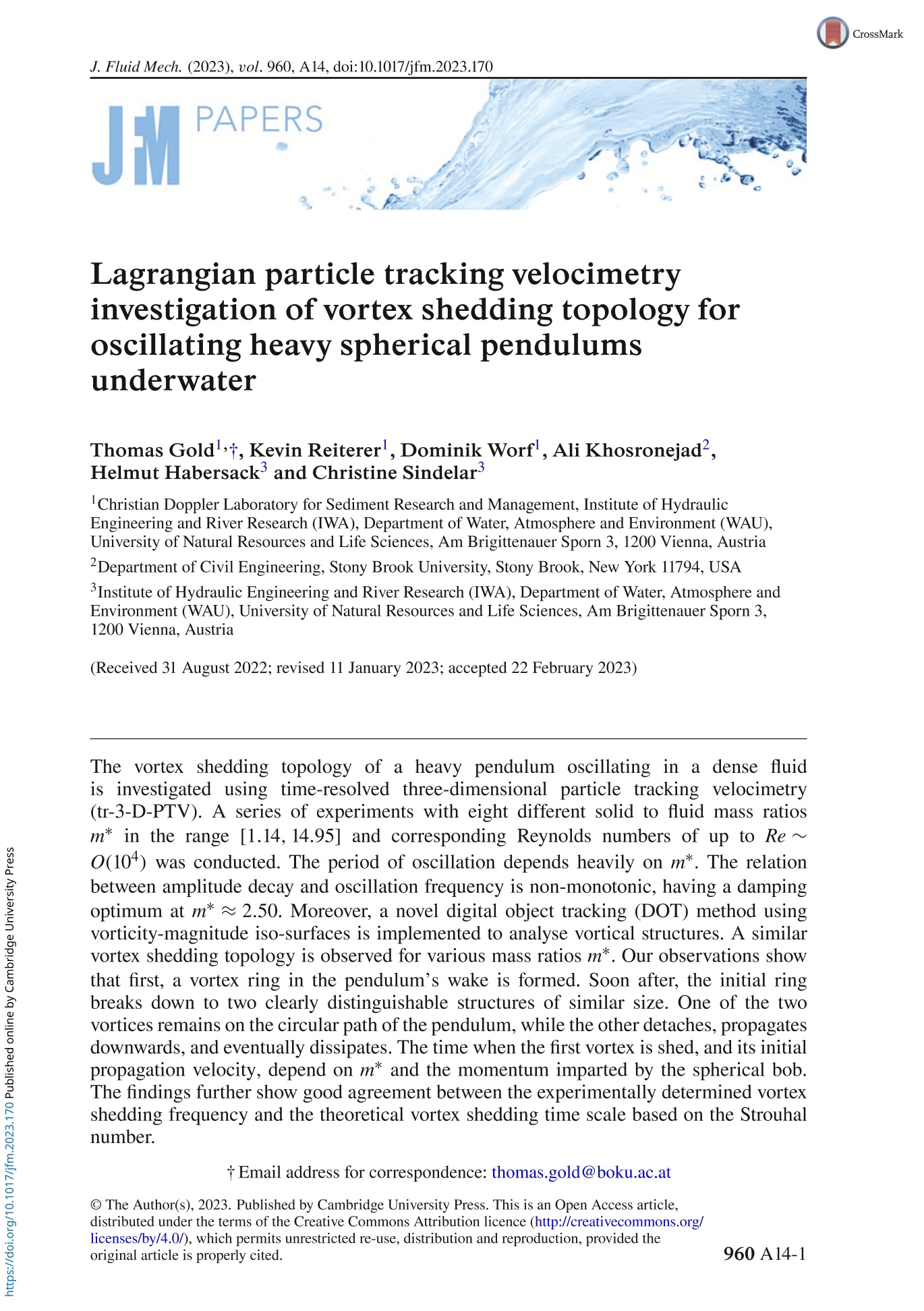
-
2/14

还剩12页未读,是否继续阅读?
继续免费阅读全文产品配置单
北京欧兰科技发展有限公司为您提供《拉格朗日粒子跟踪测速技术研究水下振荡重球摆的漩涡屏障拓扑结构》,该方案主要用于航空中 速度场检测,参考标准《暂无》,《拉格朗日粒子跟踪测速技术研究水下振荡重球摆的漩涡屏障拓扑结构》用到的仪器有Shake-the Box 高空间分辨体视粒子跟踪测速、LaVision DaVis 智能成像软件平台。
我要纠错
推荐专场
相关方案


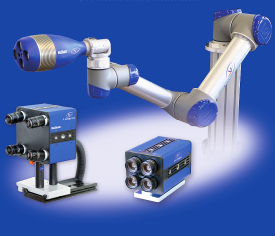
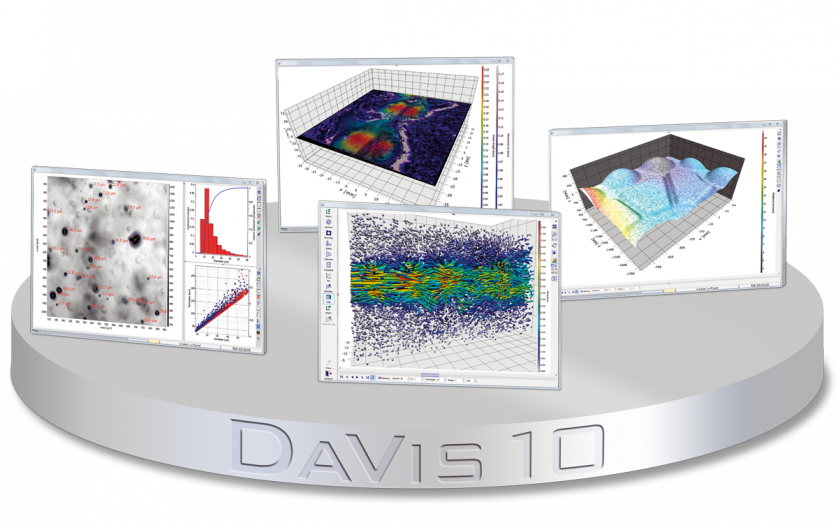
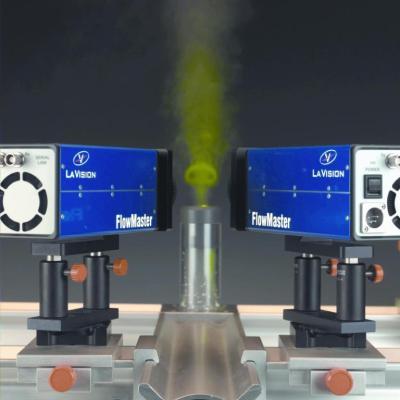
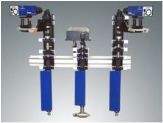



 咨询
咨询




